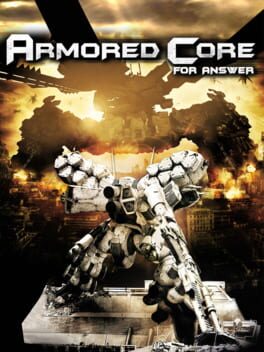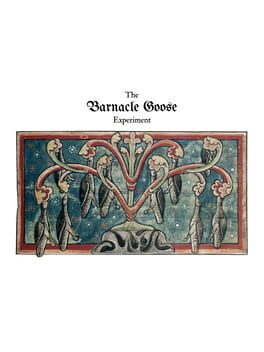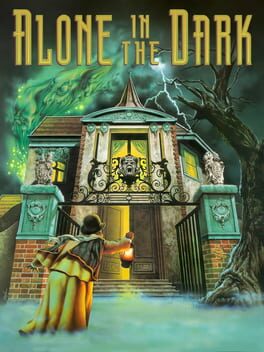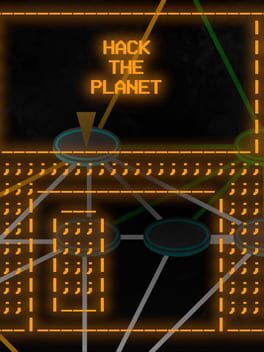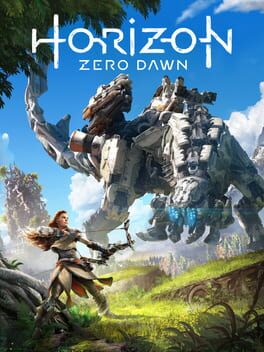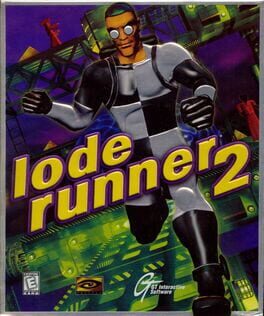nex3
BACKER
I admire this game intensely. It is immediately and overwhelmingly devoted to customization, from the path through the game all the way down to the details of the mech's center of gravity and precise energy usage. It swarms with the endless mindboggling stats of a JRPG at the same time as it refuses the core conceit of building up a character: in ACFA, all choices are reversible, all equipment can be sold back at cost, and you can build a new mech from the ground up for each mission if you so choose.
This deep and loving mechanical crunchiness is wed to an equally strong love of the aesthetically famously immortalized as "wow cool robot." ACFA goes to every length a PS3 game can to make playing it feel cool. It understands that frictionless translation between the player's thoughts and the mech's actions isn't the goal. Even the most badass mech is still a physical object and you can feel its momentum as it pivots or struggles to raise itself into the sky. This friction is crucial to the balance of the game, in fact, since it allows mechs to trade defense and power for maneuverability and speed.
With all my admiration now laid out, though, I have to say: I found ACFA intensely frustrating as well. It's difficult, sure, but it's also opaque—which I found quite surprising, since I consider FromSoft's modern works exemplars of a pedagogical approach to game design. But here, when I died over and over (particularly in one-on-one mech fights) I couldn't understand why and I couldn't figure out how to improve. Shots would hit me and miss my opponents. Players move much faster than the camera so I'd lose track of enemy positions. Worst of all, without enemy health bars incremental improvements in my skill were all but invisible.
I have no doubt that with dedication these skills can be learned. I may have been verging on that point myself before my emulator crashed and I lost enough progress to become demoralized about redoing it all. But I consider the process of bringing a player from 0% to 70% skill one of the most interesting aspects of game design, and I'll be very curious to see how they tackle it in Armored Core VI a decade and a half on from this and with the eyes of the world upon them.
This deep and loving mechanical crunchiness is wed to an equally strong love of the aesthetically famously immortalized as "wow cool robot." ACFA goes to every length a PS3 game can to make playing it feel cool. It understands that frictionless translation between the player's thoughts and the mech's actions isn't the goal. Even the most badass mech is still a physical object and you can feel its momentum as it pivots or struggles to raise itself into the sky. This friction is crucial to the balance of the game, in fact, since it allows mechs to trade defense and power for maneuverability and speed.
With all my admiration now laid out, though, I have to say: I found ACFA intensely frustrating as well. It's difficult, sure, but it's also opaque—which I found quite surprising, since I consider FromSoft's modern works exemplars of a pedagogical approach to game design. But here, when I died over and over (particularly in one-on-one mech fights) I couldn't understand why and I couldn't figure out how to improve. Shots would hit me and miss my opponents. Players move much faster than the camera so I'd lose track of enemy positions. Worst of all, without enemy health bars incremental improvements in my skill were all but invisible.
I have no doubt that with dedication these skills can be learned. I may have been verging on that point myself before my emulator crashed and I lost enough progress to become demoralized about redoing it all. But I consider the process of bringing a player from 0% to 70% skill one of the most interesting aspects of game design, and I'll be very curious to see how they tackle it in Armored Core VI a decade and a half on from this and with the eyes of the world upon them.
Mechanically, a clever variant on the idle genre that manages to hit the satisfaction of constant growth without ever actually giving you a thing that automates your clicks. You only get to the point where your clicks are the only limit to your progress well into the game, and even then in a constrained context—a logarithmic-scale idle game rather than exponential-scale, and to my mind more fun for it. The experiments at the heart of the game bring an aspect of exploration to the genre which my wife aptly describes as "the map discovery of a 4X + cooking in your kitchen + being four and combining dirt and leaves and water in the backyard to see what happens".
Thematically, haunting and intriguing and baffling in all the right measures—particularly once you brew up a radio and start listening to the excellent soundtrack. Evergreen Branca is a character whose only explicit personality comes from their opening letter, but they're well-defined even so by the empty space you see of them in the letters they abiogenerate. Even comes the brief descriptions of objects and locations feel like they come from Dr. Branca's wry and weary mind, rather than a separate narrator.
Altogether a short, quiet game but an affecting one.
Thematically, haunting and intriguing and baffling in all the right measures—particularly once you brew up a radio and start listening to the excellent soundtrack. Evergreen Branca is a character whose only explicit personality comes from their opening letter, but they're well-defined even so by the empty space you see of them in the letters they abiogenerate. Even comes the brief descriptions of objects and locations feel like they come from Dr. Branca's wry and weary mind, rather than a separate narrator.
Altogether a short, quiet game but an affecting one.
2022
There is a pattern with very few exceptions in the way I experience modular narrative games. The beginning of the game lays out a structure—the game's mechanical thesis—and I begin to understand ways in which that structure can be used to tell brilliant intertwining stories in ways that haven't been possible before. And then, inevitably, as I begin to approach the end of the game, I realize that it will not live up to the promise of its own structures, and however beautifully it weaves its story it will live in the shadow of what could have been.
Pentiment's story is doubtlessly beautiful. It takes a small town in an unglamorized time in history and tells a gripping tale that combines religion, politics, and humanity together as deftly (and with as much research) as any lauded novel of historical fiction. The comparison to Middlemarch is perhaps obvious, but well-earned. And it gives the player ample opportunity to influence characterization without making the protagonist a cipher with no personality of his own.
In the beginning, Pentiment tries to give the player a similar level of control of the narrative with a brilliant structure in which the player is presented with a buffet of choices of what to investigate and who to dine with, but with only a few days to allocate between them so that many paths remain unexplored. Allowing a single playthrough to miss major chunks of content is absolutely necessary for a narrative game to truly be modular, and this structure facilitates that while also presenting the player with a meta-puzzle across multiple playthroughs: learn what each of these events gets you, what information you get or friendships you make, and what is duplicated across different events. Combine this with the player's chosen traits and dialog options opening or closing different paths, and then hide the heart of the game within this web so that only by deeply understanding the town outside the minds of the protagonist—by becoming in a way its protector-saint—can you truly understand its secrets and navigate its innermost channels.
Despite creating a structure in which this is possible, a genuinely inspired combination of Inkle games and dating sims, Pentiment instead lets this structure fall by the wayside to the extent that the last third of the game is almost completely on rails—the player can and probably will see everything the game has to offer at that point, no matter what. Although the narrative is still marvelous it's no longer modular, and it only functions as a game within the scope of a few conversations and the player's trudging between screens.
And, oh, what trudging it is. Although I mourn for its unfulfilled potential and there are increasingly many glitchy moments or unedited lines as the game goes on (the result of a rushed end of production?), the truest deepest flaw of Pentiment is surely the amount of time a dedicated player will simply spend moving from screen to screen. In every hour any part of the map could have a new event or new dialog—but almost none actually do. There are just precisely enough that the player is motivated to check everywhere over and over again, wasting cumulative hours of real human time.
But if Pentiment's mechanics are a little underconsidered and their quality occasionally slapdash, it's still a miracle that it exists at all. I never thought I'd see a AAA studio, a Microsoft subsidiary no less, make something like this that is so openly in conversation with this genre which has for decades been exclusively the territory of indie games (and indeed was rarely a big name there either). I dearly hope that this helps legitimize that space and expands both its popularity and marketability, and I dream as I always have of the day when someone makes a game that truly grasps the potential towards which games like Pentiment extend their hands.
Pentiment's story is doubtlessly beautiful. It takes a small town in an unglamorized time in history and tells a gripping tale that combines religion, politics, and humanity together as deftly (and with as much research) as any lauded novel of historical fiction. The comparison to Middlemarch is perhaps obvious, but well-earned. And it gives the player ample opportunity to influence characterization without making the protagonist a cipher with no personality of his own.
In the beginning, Pentiment tries to give the player a similar level of control of the narrative with a brilliant structure in which the player is presented with a buffet of choices of what to investigate and who to dine with, but with only a few days to allocate between them so that many paths remain unexplored. Allowing a single playthrough to miss major chunks of content is absolutely necessary for a narrative game to truly be modular, and this structure facilitates that while also presenting the player with a meta-puzzle across multiple playthroughs: learn what each of these events gets you, what information you get or friendships you make, and what is duplicated across different events. Combine this with the player's chosen traits and dialog options opening or closing different paths, and then hide the heart of the game within this web so that only by deeply understanding the town outside the minds of the protagonist—by becoming in a way its protector-saint—can you truly understand its secrets and navigate its innermost channels.
Despite creating a structure in which this is possible, a genuinely inspired combination of Inkle games and dating sims, Pentiment instead lets this structure fall by the wayside to the extent that the last third of the game is almost completely on rails—the player can and probably will see everything the game has to offer at that point, no matter what. Although the narrative is still marvelous it's no longer modular, and it only functions as a game within the scope of a few conversations and the player's trudging between screens.
And, oh, what trudging it is. Although I mourn for its unfulfilled potential and there are increasingly many glitchy moments or unedited lines as the game goes on (the result of a rushed end of production?), the truest deepest flaw of Pentiment is surely the amount of time a dedicated player will simply spend moving from screen to screen. In every hour any part of the map could have a new event or new dialog—but almost none actually do. There are just precisely enough that the player is motivated to check everywhere over and over again, wasting cumulative hours of real human time.
But if Pentiment's mechanics are a little underconsidered and their quality occasionally slapdash, it's still a miracle that it exists at all. I never thought I'd see a AAA studio, a Microsoft subsidiary no less, make something like this that is so openly in conversation with this genre which has for decades been exclusively the territory of indie games (and indeed was rarely a big name there either). I dearly hope that this helps legitimize that space and expands both its popularity and marketability, and I dream as I always have of the day when someone makes a game that truly grasps the potential towards which games like Pentiment extend their hands.
2022
Shockingly brilliant and relentlessly at war with itself, you could probably create the perfect Sonic game by taking a list of every design decision Frontiers makes and doing the exact same thing or the exact opposite. It is a game defined by its contradictions. It is a game about going fast; jumping loses all your momentum. It's the first Sonic game whose levels I've enjoyed enough to try optimizing; its challenge times are a joke and it has no way to compare times with others or yourself. It asks you to track a complex web of set pieces through the sky; it has pop-in so bad that most of those set pieces are totally invisible unless you're practically on top of them.
Among a sea of open world games, Sonic Frontiers is one of precious few to deeply innovate on the form. It stridently makes the case that the act of movement through the world can be intrinsic to play rather than a chore to accomplish once and then hide behind fast travel forever after. And once it's given the player just enough time to internalize that lesson, it undercuts itself completely by adding a totally unnecessary fast travel system.
The cyberspace levels (classic self-contained Sonic level design) are layered and engaging—but only if you know how to use the undocumented Magnet Dash technique, wherein you cancel a homing attack into a massive air dash. This trick hits the perfect balance of being doable even by a non-speedrunner like me, totally recontextualizing level designs, and being conditional enough to keep the structure of the level relevant. But while some levels feel like they were designed with it in mind, others will trap you in inaccessible level geometry or totally wreck your camera.
Here's the thing, though: whatever else it may be, Sonic Frontiers is interesting. Some of its choices may be agonizingly conservative or blatantly stupid, true, but many are bold and an impressive number of those end up panning out. It's a AAA game that's messy and outré and occasionally fabulously daring at a time when AAA has come increasingly to mean intense polish and rigid uniformity. That alone is worth celebrating.
Among a sea of open world games, Sonic Frontiers is one of precious few to deeply innovate on the form. It stridently makes the case that the act of movement through the world can be intrinsic to play rather than a chore to accomplish once and then hide behind fast travel forever after. And once it's given the player just enough time to internalize that lesson, it undercuts itself completely by adding a totally unnecessary fast travel system.
The cyberspace levels (classic self-contained Sonic level design) are layered and engaging—but only if you know how to use the undocumented Magnet Dash technique, wherein you cancel a homing attack into a massive air dash. This trick hits the perfect balance of being doable even by a non-speedrunner like me, totally recontextualizing level designs, and being conditional enough to keep the structure of the level relevant. But while some levels feel like they were designed with it in mind, others will trap you in inaccessible level geometry or totally wreck your camera.
Here's the thing, though: whatever else it may be, Sonic Frontiers is interesting. Some of its choices may be agonizingly conservative or blatantly stupid, true, but many are bold and an impressive number of those end up panning out. It's a AAA game that's messy and outré and occasionally fabulously daring at a time when AAA has come increasingly to mean intense polish and rigid uniformity. That alone is worth celebrating.
2022
An extremely smart intersection of mechanics from orthodox Resident Evil and orthodox Silent Hill, very little in Signalis feels wholly new but the craft with which it's deployed contextualizes it in a new way. The burn mechanic (destroy a corpse or it will return to life eventually) is borrowed from REGCN, but it allows Signalis to make its infrequent and out-of-the-way save points risky to get to and from, recreating an emergent version of RE's iconic save economy despite the use of SH-style save points.
My favorite mechanical consequence is the way the strict 6-item inventory limit forces players to create their own ad hoc class. Sure, there are items that can heal you fast, items that can heal for a lot, items that can heal automatically—but when you're moving into a new room and you need three spare inventory slots just in case, you can only choose one. You can only choose one weapon as well, and you may have to choose between bringing any healing at all or a torch to dispose of corpses. How you do so defines your character and your experience of the game as surely as any stat selection.
My favorite mechanical consequence is the way the strict 6-item inventory limit forces players to create their own ad hoc class. Sure, there are items that can heal you fast, items that can heal for a lot, items that can heal automatically—but when you're moving into a new room and you need three spare inventory slots just in case, you can only choose one. You can only choose one weapon as well, and you may have to choose between bringing any healing at all or a torch to dispose of corpses. How you do so defines your character and your experience of the game as surely as any stat selection.
1999
It's impossible not to compare this to Resident Evil. This game shines on a narrative level: the plot is more robust and interesting and the environment design leans substantially less heavily on existing horror tropes and ends up legitimately unsettling as a result. The mechanics, on the other hand, are much less revelatory and end up decidedly obnoxious in boss fights that turn the tank controls from an artistic decision to a pure impediment.
The biggest innovation relative to the survival horror progenitor is the wide open city overworld shrouded in the series's iconic fog. This turns the whole dynamic of the game's resource management on its head. No longer do foes exist exclusively on a room-by-room basis, where figuring out how to successfully route around an enemy is as valid a solution as killing it. Silent Hill presents a version of the dungeon crawler's core question: will you take the risk of exploration in exchange for the rewards you may find?
Broadly speaking, if you're decent at the game, killing the foes you encounter in the overworld so you can explore it thoroughly will give you more resources than you spend. On the other hand, if you (like me) try to play this like Resident Evil and conserve your healing items and ammunition by carefully avoiding combat while making your way directly to your next objective, you'll miss not just useful items but a deeper understanding of the plot and indeed the possibility of a good ending.
Silent Hill thus ends up being a very different kind of survival horror. You're certainly still hoarding resources, but you're not running scared in the same way. The game throws frightening beasts at you but it also asks that you learn to face down and overcome them. In doing so, it dilutes the fear somewhat, and I think that's a bit of a shame.
The biggest innovation relative to the survival horror progenitor is the wide open city overworld shrouded in the series's iconic fog. This turns the whole dynamic of the game's resource management on its head. No longer do foes exist exclusively on a room-by-room basis, where figuring out how to successfully route around an enemy is as valid a solution as killing it. Silent Hill presents a version of the dungeon crawler's core question: will you take the risk of exploration in exchange for the rewards you may find?
Broadly speaking, if you're decent at the game, killing the foes you encounter in the overworld so you can explore it thoroughly will give you more resources than you spend. On the other hand, if you (like me) try to play this like Resident Evil and conserve your healing items and ammunition by carefully avoiding combat while making your way directly to your next objective, you'll miss not just useful items but a deeper understanding of the plot and indeed the possibility of a good ending.
Silent Hill thus ends up being a very different kind of survival horror. You're certainly still hoarding resources, but you're not running scared in the same way. The game throws frightening beasts at you but it also asks that you learn to face down and overcome them. In doing so, it dilutes the fear somewhat, and I think that's a bit of a shame.
2014
I write this journal having finished my run in the 80 Days in 80 Days race that I organized. It took me 68 days, both in the real world and in the game. This experience, and watching so many people go through it with me, has given me a new appreciation for both the successes and the failings of this game.
Plunging several dozen people into it, many of whom had never played before, with other peoples' routes to compare themselves to has thrown into relief just how frustrating the 80 Days' foibles can be. There are a number of UI issues that create pure misery, especially in the context of a game with a constantly-ticking clock. Why is it to hard to tell that you can often purchase extra luggage? Why does clicking on the background boot you from the market? Why does the game allow you to pay good money to accelerate a departure you can't afford anyway?
Despite all of this, I'm still convinced this is a masterpiece. These are ultimately quibbles—they undeniably suck for first-time players, but they're easy enough to learn to avoid. The other thing this race has taught me is just how much variety is packed into the game. I've kept a map of everyone's routes, and it's crisscrossed all over the place. Every player took a unique route and had a unique experience, even on the same starting seed. It's a delight to see, and I wish there was any other game like it.
Plunging several dozen people into it, many of whom had never played before, with other peoples' routes to compare themselves to has thrown into relief just how frustrating the 80 Days' foibles can be. There are a number of UI issues that create pure misery, especially in the context of a game with a constantly-ticking clock. Why is it to hard to tell that you can often purchase extra luggage? Why does clicking on the background boot you from the market? Why does the game allow you to pay good money to accelerate a departure you can't afford anyway?
Despite all of this, I'm still convinced this is a masterpiece. These are ultimately quibbles—they undeniably suck for first-time players, but they're easy enough to learn to avoid. The other thing this race has taught me is just how much variety is packed into the game. I've kept a map of everyone's routes, and it's crisscrossed all over the place. Every player took a unique route and had a unique experience, even on the same starting seed. It's a delight to see, and I wish there was any other game like it.
1992
Historically fascinating but very rough to play, even by the standards of its era. After playing Resident Evil I fully bought into the use of tank controls as a way of creating cinematic shots, but the average camera angle in this game is much less artful—although there is the occasional inspired moment, like switching to a shot outside the window looking in at yourself just before a monster bursts through. But I can forgive many control scheme fumbles in such an early 3D game.
What really gets me is the combat. Not the controls, which are actually fairly clever once you get the hang of them, but the absolute opacity of what's expected of the player. Some enemies will crumple from a few hits, but others seem to be effectively invulnerable, with no rhyme or reason as to why. I stabbed a rat a dozen times with a knife and it never died—but crucially, it did fall back and emit a gout of blood, which should have been a clear signal that it was getting injured.
I don't mind being weak and pathetic. It's a baseline expectation of the genre, and it's cool to see it present right here at the root. But when a rat or a spider is indestructible, it diminishes the fear of the highly-destructible zombies and birds you also fight. When you can't enter a room not because its resident is too strong for you, but because it randomly ended up camped in the doorway and a single hit will stagger you back out of the room, it brings mechanics into primacy over mood in a way that diminishes the effectiveness of the game.
Frustrations aside, it's fascinating how Alone in the Dark engages with saved games. Where its successors parcel out saves as a resource to be carefully applied, this game not only allows you to save freely, it demands you do so. Death comes swiftly and unexpectedly. Walk in the wrong space, open the wrong door, get cornered by a rat, and you're gone. You can even end up soft-locking yourself without noticing, only to find out much later. The rational response is to hoard a mountain of saves in different places at different times to be able to stitch together one final flawless run—foreshadowing a common mode of play for stealth games in the process.
What really gets me is the combat. Not the controls, which are actually fairly clever once you get the hang of them, but the absolute opacity of what's expected of the player. Some enemies will crumple from a few hits, but others seem to be effectively invulnerable, with no rhyme or reason as to why. I stabbed a rat a dozen times with a knife and it never died—but crucially, it did fall back and emit a gout of blood, which should have been a clear signal that it was getting injured.
I don't mind being weak and pathetic. It's a baseline expectation of the genre, and it's cool to see it present right here at the root. But when a rat or a spider is indestructible, it diminishes the fear of the highly-destructible zombies and birds you also fight. When you can't enter a room not because its resident is too strong for you, but because it randomly ended up camped in the doorway and a single hit will stagger you back out of the room, it brings mechanics into primacy over mood in a way that diminishes the effectiveness of the game.
Frustrations aside, it's fascinating how Alone in the Dark engages with saved games. Where its successors parcel out saves as a resource to be carefully applied, this game not only allows you to save freely, it demands you do so. Death comes swiftly and unexpectedly. Walk in the wrong space, open the wrong door, get cornered by a rat, and you're gone. You can even end up soft-locking yourself without noticing, only to find out much later. The rational response is to hoard a mountain of saves in different places at different times to be able to stitch together one final flawless run—foreshadowing a common mode of play for stealth games in the process.
2022
A fantastically brutalist game, not in the sense of having angular concrete buildings but in the original sense of showcasing the raw materials with which it's constructed. Automaton Lung wants you to be hyper-aware at every instant that it is a video game, that the world you are seeing is virtual, that the actions you take follow the "explore and collect" script at the heart of so much of the medium.
It doesn't take on the self-defeating preachy tone of some games which seem to say "how dare you engage in such a pursuit." It's no simplistic morality tale. It just wants to revel in what it is, and it wants you to join in as well. All it asks of the player is "see me for what I am."
Everything in the game shows off the materiality of its creation. The icons on the touch screen show off their individual pixels (well larger than anything another game might call a "pixel art style") like a peacock spreading its feathers. The platforming puzzles ask you to familiarize yourself with the fine details of how your model interacts with the models around you. The cramped level geometries clip the camera briefly out of bounds and show the skeleton of the world you're traversing.
Even the total lack of introductory explanation emphasizes the clear truth: you already know what the game wants of you simply because it is a game. You see a colorful cube sending smaller yellow cubes your way, and you know that an enemy is shooting you and you must shoot back or die. You see a small spinning square floating in space, and you know you must touch it to obtain it for some future reward. You find yourself within an architecture and so you must chart its rooms and hallways.
If digital brutalism is its underlying motivator, the architecture of the world is the great triumph of Automaton Lung's moment-to-moment experience. Every area you visit creates its own sense of space with its own distinct mood. They are "levels" in several senses, but they're also rooms and buildings and monuments and cathedrals through which the game guides the player.
The deeper you get in, the clearer it becomes that the chips aren't only collectables, but wordless signposts. Not just "good job", but "check out this view." "Walk through this passage." "You can get here, I promise, and it will be worth it." The raw material of gameplay is turned inward to compel the player to experience the raw material of gamespace. The architecture of the design is as beautiful as the architecture of the world.
It doesn't take on the self-defeating preachy tone of some games which seem to say "how dare you engage in such a pursuit." It's no simplistic morality tale. It just wants to revel in what it is, and it wants you to join in as well. All it asks of the player is "see me for what I am."
Everything in the game shows off the materiality of its creation. The icons on the touch screen show off their individual pixels (well larger than anything another game might call a "pixel art style") like a peacock spreading its feathers. The platforming puzzles ask you to familiarize yourself with the fine details of how your model interacts with the models around you. The cramped level geometries clip the camera briefly out of bounds and show the skeleton of the world you're traversing.
Even the total lack of introductory explanation emphasizes the clear truth: you already know what the game wants of you simply because it is a game. You see a colorful cube sending smaller yellow cubes your way, and you know that an enemy is shooting you and you must shoot back or die. You see a small spinning square floating in space, and you know you must touch it to obtain it for some future reward. You find yourself within an architecture and so you must chart its rooms and hallways.
If digital brutalism is its underlying motivator, the architecture of the world is the great triumph of Automaton Lung's moment-to-moment experience. Every area you visit creates its own sense of space with its own distinct mood. They are "levels" in several senses, but they're also rooms and buildings and monuments and cathedrals through which the game guides the player.
The deeper you get in, the clearer it becomes that the chips aren't only collectables, but wordless signposts. Not just "good job", but "check out this view." "Walk through this passage." "You can get here, I promise, and it will be worth it." The raw material of gameplay is turned inward to compel the player to experience the raw material of gamespace. The architecture of the design is as beautiful as the architecture of the world.
2022
Short and sweet, the star of this game is really the writing. Cyberpunk's notional anti-authoritarianism is so often nebulous to the point of failing to make any kind of political point, but not here. Hack the Planet is stridently leftist, from the anti-corporate manifesto of the User Unknown BBS to the grand prize of doxxing hundreds of cops. It's also just a fun time, learning the ins and outs of 4TRESS's network defenses while dodging spiders and shooting the shit with your hacker pals.
2022
Hands down Sam Barlow's best work so far. Switching from textual to visual searches is a brilliant move in conjunction with a shift in storytelling from the literal to the symbolic, drawing the player's attention over and over again to the images that are shared across the stories. The mechanics themselves blur the line between the sign and its meaning, linking a picture at now to another picture and now to the person the picture depicts, harmonizing with the thematic focus on the dissolving boundary between actor, role, and audience.
Immortality is Lynchian, in the sense that it uses a nexus of symbols and raw emotion to argue that the banal humanity of everyday life affects and reflects the grand arcs of humanity. Although the initially-obscure narrative does eventually take clearer form once you dive deep into the depths of the game, it remains resolutely unwilling to sacrifice the breadth of its symbolic resonance at the altar of "lore" by answering every question the player has. It is a game that sticks in one's mind and demands to be mulled over again and again, rewarding this thought with glimmers of insight that feel deeply earned.
Immortality is Lynchian, in the sense that it uses a nexus of symbols and raw emotion to argue that the banal humanity of everyday life affects and reflects the grand arcs of humanity. Although the initially-obscure narrative does eventually take clearer form once you dive deep into the depths of the game, it remains resolutely unwilling to sacrifice the breadth of its symbolic resonance at the altar of "lore" by answering every question the player has. It is a game that sticks in one's mind and demands to be mulled over again and again, rewarding this thought with glimmers of insight that feel deeply earned.
I picked this up for the nostalgia trip—I came back to it over and over again as a young child but never managed to make much headway on the riddles. As an adult, though, in addition to being endlessly charmed by the CGI/FMV hybridization, I was deeply impressed by how thoughtfully designed the game is.
The player is challenged to solve seven scientific riddles in order to satisfy a rogue AI and persuade it to divert a meteoroid before it collides with earth in five days' time. Doing so involves a point-and-click mixture of learning scientific facts and applying them to interactive puzzles, eventually yielding some object that you can submit as a riddle solution.
On the surface this is fairly standard mid-90s fare, although it's clear that the creators had a lot of fun cramming it full of goofs, science facts, and references to the Bill Nye show. But there's also a keen eye here towards the way the player approaches the game: although Nye Labs is fairly open to exploration, the puzzles are set up to gently guide you through in a particular order, gating challenges on one another or just on exploration through the space.
It's even clear that my childhood mode of play, to fail over and over again to actually stop the meteoroid, was an intended pattern. Very little in the game is mechanically off-limits. Instead, it's almost exclusively blocked by knowledge. Once you're aware of how to solve one or another riddle (or even enter the one explicitly locked area of the lab), you can do it instantly in your next session. The game expects the player to learn over time not just in terms of science but in terms of the space it creates.
The player is challenged to solve seven scientific riddles in order to satisfy a rogue AI and persuade it to divert a meteoroid before it collides with earth in five days' time. Doing so involves a point-and-click mixture of learning scientific facts and applying them to interactive puzzles, eventually yielding some object that you can submit as a riddle solution.
On the surface this is fairly standard mid-90s fare, although it's clear that the creators had a lot of fun cramming it full of goofs, science facts, and references to the Bill Nye show. But there's also a keen eye here towards the way the player approaches the game: although Nye Labs is fairly open to exploration, the puzzles are set up to gently guide you through in a particular order, gating challenges on one another or just on exploration through the space.
It's even clear that my childhood mode of play, to fail over and over again to actually stop the meteoroid, was an intended pattern. Very little in the game is mechanically off-limits. Instead, it's almost exclusively blocked by knowledge. Once you're aware of how to solve one or another riddle (or even enter the one explicitly locked area of the lab), you can do it instantly in your next session. The game expects the player to learn over time not just in terms of science but in terms of the space it creates.
2020
There are things this game does that I actually really love. It has moments of a Gnog-like playfulness where it rewards a player's organic exploration of the surface of the game (roll a big snowball! surf on a surfboard!). At times it really seems to prioritize the texture of play as a way to showcase the haptic capabilities of the new controller. The monkey suit could be an entire little game on its own.
The problem is that these moments of genuine joy are drowning in a pro forma V I D E O G A M E that's full of enemies, platforming, and levels. What's worse, the entire thing is just a huge advertisement for the PS5. Its existence on the console by default and for free casts small and playful games as valueless relative to the AAA content behemoths that are the PlayStation's stock in trade these days, and its ceaseless references to Sony's history are heartbreaking in light of its destaffing of the Japanese teams that made the very games it lionizes.
More than anything, Astro's Playground makes me feel melancholy. It's a glimpse at a crossroads where the route has already been chosen, and so in a way it's a eulogy for the path the industry refused to take.
The problem is that these moments of genuine joy are drowning in a pro forma V I D E O G A M E that's full of enemies, platforming, and levels. What's worse, the entire thing is just a huge advertisement for the PS5. Its existence on the console by default and for free casts small and playful games as valueless relative to the AAA content behemoths that are the PlayStation's stock in trade these days, and its ceaseless references to Sony's history are heartbreaking in light of its destaffing of the Japanese teams that made the very games it lionizes.
More than anything, Astro's Playground makes me feel melancholy. It's a glimpse at a crossroads where the route has already been chosen, and so in a way it's a eulogy for the path the industry refused to take.
2017
Agonizingly AAA. Surprisingly racist, even for mainstream Western media. No idea how to motivate a character beyond "my loved one is dead". Bottomless disdain for the player. But damned if they didn't make fighting a robot t-rex pretty fucking sick. The combat is the real selling point, and between setting up traps, capitalizing on weak spots, and carefully choosing skills it made me feel consistently clever.
I can't fathom how embarrassing this must have been to release next to Breath of the Wild though. A game with graphics a full console generation worse than this that nevertheless runs circles around its open world design. Even knowing this was pre-BotW I keep trying to go to spots that look interesting on the map and being crushed when there's nothing there or, worse, it's totally inaccessible.
I can't fathom how embarrassing this must have been to release next to Breath of the Wild though. A game with graphics a full console generation worse than this that nevertheless runs circles around its open world design. Even knowing this was pre-BotW I keep trying to go to spots that look interesting on the map and being crushed when there's nothing there or, worse, it's totally inaccessible.
1998
This game is very cool, and if I'd owned it in 1998 when I had a boundless fountain of time and patience to pour into any game I managed to get my hands on I would have absolutely adored it. The PC branch of the Lode Runner family tree zooms in on the puzzleyness of the game rather than the action elements, and this entry takes those puzzles into three dimensions on an isomorphic three-axis grid.
It's hard to overstate how appealing the graphics of this game still are. Sprite graphics make lavish detail economical to a degree that 3D games can never be, and the isometric perspective gives this a dimensionality that side-view graphics always lack. In combination, these create lush screens bursting with details that beg you to explore, to peek behind a wall or pass through a tunnel or—using Lode Runner's characteristic mechanic—dig for treasure.
As much as I loved looking at the game, I found actually playing it to be a bit stressful. The pure puzzle levels were great, but it wouldn't be Lode Runner without angry guards after your throat, and navigating around them while locked to the grid of tiles was more than I wanted to subject my exhausted 2022 self to for more than an hour or two. This is the game's core mechanical flaw: the isomorphic grid and the player's movement on it are tailor-made for a turn-based puzzle game, but the words "lode runner" written on the box demand obeisance to the series's action roots.
The action history is also apparent in the game's scoring system, which is based on how quickly you complete the level. In a more modern (or less Lode Runner) game, this would probably be a move counter instead... although there's a real brilliance to its inclusion either way. As contemporary players are busy rediscovering with Neon White, the simple addition of a timer and a leaderboard creates a new dimension of puzzles. Rather than finding any route through the level, the goal is to find the best one—quite a challenge when you have a tool as flexible as Lode Runner's dig command. It's a real shame that this game wasn't released in the era of online leaderboards, because I imagine the competition would have been fierce.
It's hard to overstate how appealing the graphics of this game still are. Sprite graphics make lavish detail economical to a degree that 3D games can never be, and the isometric perspective gives this a dimensionality that side-view graphics always lack. In combination, these create lush screens bursting with details that beg you to explore, to peek behind a wall or pass through a tunnel or—using Lode Runner's characteristic mechanic—dig for treasure.
As much as I loved looking at the game, I found actually playing it to be a bit stressful. The pure puzzle levels were great, but it wouldn't be Lode Runner without angry guards after your throat, and navigating around them while locked to the grid of tiles was more than I wanted to subject my exhausted 2022 self to for more than an hour or two. This is the game's core mechanical flaw: the isomorphic grid and the player's movement on it are tailor-made for a turn-based puzzle game, but the words "lode runner" written on the box demand obeisance to the series's action roots.
The action history is also apparent in the game's scoring system, which is based on how quickly you complete the level. In a more modern (or less Lode Runner) game, this would probably be a move counter instead... although there's a real brilliance to its inclusion either way. As contemporary players are busy rediscovering with Neon White, the simple addition of a timer and a leaderboard creates a new dimension of puzzles. Rather than finding any route through the level, the goal is to find the best one—quite a challenge when you have a tool as flexible as Lode Runner's dig command. It's a real shame that this game wasn't released in the era of online leaderboards, because I imagine the competition would have been fierce.
